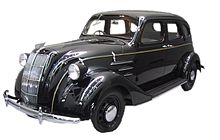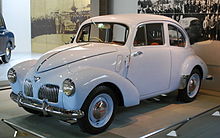History of Toyota
This article needs to be updated. The reason given is: What happened after 2014 and before 2008?. (February 2024) |


The history of
Although the Toyota Group is best known today for its cars, it is still in the textile business and still makes automatic looms, which are now computerized, and electric sewing machines which are available worldwide.
Beginning
Toyota Motor Co. was established as an independent and separate company in 1937. Although the founding family's name was written in the
With the Japanese economy modernizing and expanding during the 1930s, both Ford and GM had built factories in Japan where vehicles were imported from America in knock down kits and assembled locally. The Ford Yokohama facility started in March 1925 and GM built a factory at Osaka starting in April 1927. By 1929, both Ford and GM controlled most of the Japanese automobile market, producing 28,000 vehicles in 1929. During development of the company's first car, the Toyota AA, the company purchased locally manufactured GM and Ford products, reverse engineered them, and hired engineers who had previously worked at the Japanese Ford and GM factories in developing Toyota products.[4]
World War II
This section needs expansion. You can help by adding to it. (October 2023) |
During the
Postwar growth

After World War II, Japan experienced extreme economic difficulty. Commercial passenger car production started in 1947 with the model SA. The company was on the brink of bankruptcy by the end of 1949, but the company eventually obtained a loan from a consortium of banks which stipulated an independent sales operation and elimination of "excess manpower".[7]
In June 1950, the company produced only 300 trucks and was on the verge of going out of business. The management announced layoffs and wage reductions, and in response the union went on a strike that lasted two months. The strike was resolved by an agreement that included layoffs and pay reductions but also the resignation of the president at the time, Kiichiro Toyoda. Toyoda was succeeded by Taizo Ishida, who was the chief executive of the Toyoda Automatic Loom company.[7] The first few months of the Korean War resulted in an order of over 5,000 vehicles from the US military, and the company was revived. Ishida was credited for his focus on investment in equipment. One example was the construction of the Motomachi Plant in 1959, which gave Toyota a decisive lead over Nissan during the 1960s.[7]
In 1950, a separate sales company, Toyota Motor Sales Co., was established (which lasted until July 1982). In April 1956, the Toyopet dealer chain was established. In 1957, the
Global presence
Toyota began to expand in the 1960s with a new research and development facility, a presence in
The first Japanese vehicles to arrive in the American continents were five Land Cruisers in El Salvador in May 1953.[9] The first Toyotas sent to Canada were a shipment of 115 Crowns sent in February 1965.[10]
The first Toyotas sent to Europe were two
2008–2012
With high fuel prices and a weak US economy in mid-2008, Toyota reported a double-digit decline in sales for the month of June, similar to figures reported by the
In January 2010, Toyota
References
- ^ Toyota Company History from 1867 to 1939
- ^ a b Toyota corporate history/Toyoland
- ^ Pollack, Andrew (1995-08-11). "Toyota Names President Outside Founding Family". The New York Times. Retrieved 2012-12-27.
- ^ "Assembly Production by Ford and General Motors". 75 years of Toyota. Toyota. Retrieved 22 November 2020.
- JSTOR 23699656.
Moreover, during the war, Toyota manufactured standard-sized trucked almost exclusively for the army, which paid one-fifth of the price in advance and the balance in cash on delivery.
- ^ "Toyota Motor Corporation". Encyclopaedia Britannica. March 2024.
During World War II the company suspended production of passenger cars and concentrated on trucks
- ^ a b c The Creators of Toyota's DNA
- ^ Toyota's first production outside Japan at Toyota do Brasil (BR)
- ^ Beltrán, Jorge (2013-04-03). "50 Aniversario de TOYOTA en El Salvador" [50th Anniversary of Toyota in El Salvador]. elsalvador.com. Retrieved 2013-05-20.
- ^ "トヨタ自動車販売(株)『モータリゼーションとともに. 資料』(1970.11)" [Toyota Motor Sales Co., Ltd. "With Motorization" document (1970.11)]. Shibusawa Shashi Database (in Japanese). Shibusawa Eiichi Memorial Foundation. p. 100. Archived from the original on 2019-12-19.
- ^ a b "Item 4. Exports of Completely-built Vehicles". 75 years of Toyota: Vehicle Lineage. Toyota Motor Co. Retrieved 2013-01-22.
- ISSN 0355-4287.
- ^ Toyota sputters as market shifts
- ^ "Toyota Cuts Back on Trucks". Time. 2008-07-11. Archived from the original on July 14, 2008. Retrieved 2010-05-04.
- ^ Loyalty to Detroit 3 slipping away | Freep.com | Detroit Free Press
- ^ Vlasic, Bill; Bunkley, Nick (2008-07-11). "Toyota Scales Back Production of Big Vehicles". The New York Times. Retrieved 2010-05-04.
- ^ "Toyota Suspends Sales of 8 Recalled Vehicle Models". foxnews.com. Associated Press. 2010-01-26. Retrieved 2010-01-27.
- ^ Zalubowski, David (2012-12-26). "Toyota settlement in sudden-acceleration case will top $1 billion". Los Angeles Times. Retrieved 2012-12-27.
